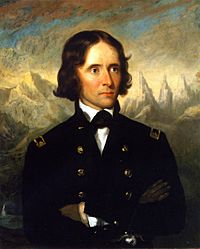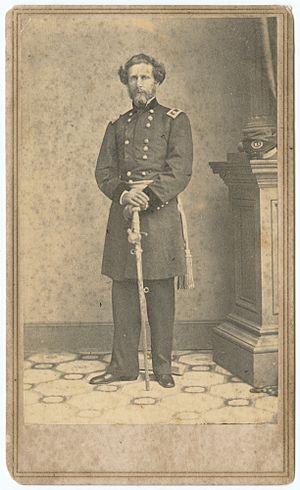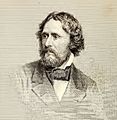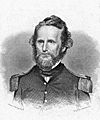John C. Frémont facts for kids
Quick facts for kids
John C. Frémont
|
|
|---|---|
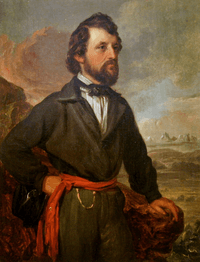
John C. Frémont, 1852 portrait, by William S. Jewett
|
|
| 5th Territorial Governor of Arizona | |
| In office October 6, 1878 – October 11, 1881 |
|
| Appointed by | Rutherford B. Hayes |
| Preceded by | John Philo Hoyt |
| Succeeded by | Frederick Augustus Tritle |
| United States Senator from California |
|
| In office September 9, 1850 – March 3, 1851 |
|
| Preceded by | None (Statehood) |
| Succeeded by | John B. Weller |
| 3rd Military Governor of California | |
| In office January 14, 1847 – March 1, 1847 |
|
| Appointed by | James K. Polk |
| Preceded by | Robert F. Stockton |
| Succeeded by | Stephen W. Kearny |
| Personal details | |
| Born |
John Charles Fremon
January 21, 1813 Savannah, Georgia, U.S. |
| Died | July 13, 1890 (aged 77) New York City, U.S. |
| Political party | Republican |
| Spouse | Jessie Benton |
| Alma mater | College of Charleston |
| Profession | Soldier |
| Signature | |
| Military service | |
| Branch/service | United States Army |
| Years of service | 1838–1848 1861–1864 |
| Rank | Major General |
| Commands | California Battalion Department of the West |
John Charles Frémont or Fremont (January 21, 1813 – July 13, 1890) was an American explorer, military officer, and politician. He was a United States senator from California and was the first Republican nominee for president of the U.S. in 1856 and founder of the California Republican Party when he was nominated. He lost the election to Democrat James Buchanan.
Frémont assisted and led multiple surveying expeditions through the western territory of the United States. In 1838 and 1839 he assisted Joseph Nicollet in exploring the lands between the Mississippi and Missouri Rivers. In 1841 he mapped portions of the Des Moines River, and from 1841 to 1846 he led exploration parties on the Oregon Trail and into the Sierra Nevada.
Contents
Early life, education, and early career
John Charles Frémont was born on January 21, 1813, the son of Charles Frémon, a French-Canadian immigrant school-teacher, and Anne Beverley Whiting, the youngest daughter of socially prominent Virginia planter Col. Thomas Whiting.
On December 8, 1818, Frémont's father died in Norfolk, Virginia, leaving Anne a widow to take care of John and several young children alone on a limited inherited income. Anne and her family moved to Charleston, South Carolina. Frémont, knowing his origins and coming from relatively modest means, grew up a proud, reserved, restless loner who although self-disciplined, was ready to prove himself and unwilling to play by the rules. A lawyer, John W. Mitchell, provided for Frémont's early education whereupon Frémont in May 1829 entered Charleston College, teaching at intervals in the countryside, but was expelled for irregular attendance in 1831. Frémont, however, had been grounded in mathematics and natural sciences.
Frémont attracted the attention of eminent South Carolina politician Joel R. Poinsett, an Andrew Jackson supporter, who secured Frémont an appointment as a teacher of mathematics aboard the sloop USS Natchez, sailing the South American seas in 1833. Frémont resigned from the navy and was appointed second lieutenant in the U.S. Topographical Corps, surveying a route for the Charleston, Louisville, and Cincinnati railroad. Working in the Carolina mountains, Frémont desired to become an explorer. Between 1837 and 1838, Frémont's desire for exploration increased while in Georgia on reconnaissance to prepare for the removal of Cherokee Indians. When Poinsett became Secretary of War, he arranged for Frémont to assist notable French explorer and scientist Joseph Nicollet in exploring the lands between the Mississippi and Missouri rivers. Frémont became a first rate topographer, trained in astronomy, and geology, describing fauna, flora, soil, and water resources.
Frémont's explorations
The opening of the American West began in 1804, when the Lewis and Clark Expedition (led by Meriwether Lewis and William Clark) started exploration of the new Louisiana Purchase territory to find a northwest passage up the Missouri River to the Pacific Ocean. President Thomas Jefferson had envisioned a Western empire, and also sent the Pike Expedition under Zebulon Pike to explore the southwest. American and European fur trappers, including Peter Skene Ogden and Jedediah Smith, explored much of the American West in the 1820s. Frémont, who would later be known as The Pathfinder, carried on this tradition of Western overland exploration, building on and adding to the work of earlier pathfinders to expand knowledge of the American West. Frémont's talent lay in his scientific documentation, publications, and maps made based on his expeditions, making the American West accessible for many Americans. Beginning in 1842, Frémont led five western expeditions, however, between the third and fourth expeditions, Frémont's career took a fateful turn because of the Mexican–American War. Frémont's initial explorations, his timely scientific reports, co-authored by his wife Jessie, and their romantic writing style, encouraged Americans to travel West. A series of seven maps produced from his findings, published by the Senate in 1846, served as a guide for thousands of American emigrants, depicting the entire length of the Oregon Trail.
Career
On January 16, 1847 he was appointed Governor of the new California Territory following the Treaty of Cahuenga which ended the Mexican-American War in California. He served briefly (from 1850 to 1851) as a Senator from California. In 1856 the new Republican Party nominated him as their first presidential candidate, but he lost (see U.S. presidential election, 1856) to James Buchanan.
Frémont served as a major general in the American Civil War and declared martial law in Missouri. This declaration led to a conflict with Abraham Lincoln and led to Frémont's removal from command in the West on November 2, 1861. He was re-appointed to a different post (in West Virginia), but lost several battles and resigned his post.
After the Civil War, Frémont's wealth declined after investing heavily and purchasing an unsuccessful Pacific Railroad in 1866, and lost much of his wealth during the Panic of 1873. Frémont served as Governor of Arizona from 1878 to 1881 appointed by President Rutherford B. Hayes.
Death
On Sunday, July 13, 1890, at the age of 77, Frémont died of peritonitis at his residence at 49 West Twenty-fifth Street in New York. His death was unexpected and his brief illness was not generally known.
Initially interred at Trinity Church Cemetery, he was reinterred in Rockland Cemetery in Sparkill, New York on March 17, 1891.
Upon Fremont's death, his wife Jessie received a Civil War Pension with an annual income of $2,000 ($65.1 thousand in 2022).
Legacy
Four states named counties in his honor: Colorado, Idaho, Iowa and Wyoming. Also, several cities are named after him, such as Fremont, California and Fremont, Nebraska.
Historians portray Frémont as controversial and contradictory. Some scholars regard him as a military hero of significant accomplishment. Frémont's published reports and maps produced from his explorations significantly contributed to massive American emigration overland into the West starting in the 1840s.
Images for kids
-
Thomas Hart Benton, U.S. Senator, Missouri, was Frémont's powerful backer in the Senate.
-
Frémont (seated right) and Kit Carson, Frémont's expeditions guide.
-
Frémont's second expedition party reached Sutter's Fort in the Sacramento Valley in March 1844
-
Frémont was blamed for Nathaniel Lyon's Union defeat at Wilson's Creek
-
Plaque at Henry Cowell Redwoods State Park, Redwood Grove trail, where Frémont camped in 1846
See also
 In Spanish: John C. Frémont para niños
In Spanish: John C. Frémont para niños



